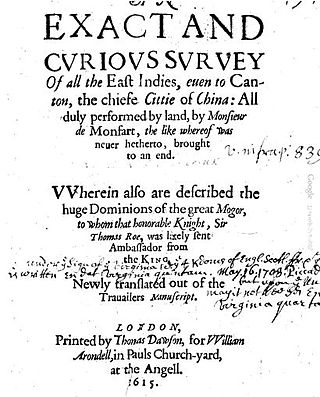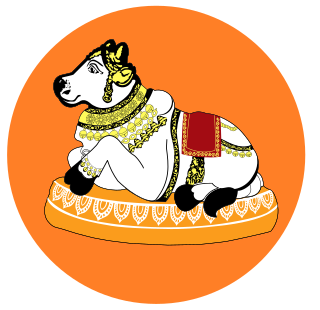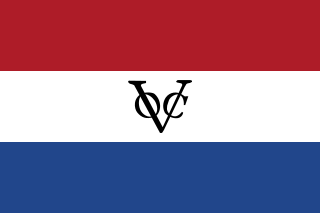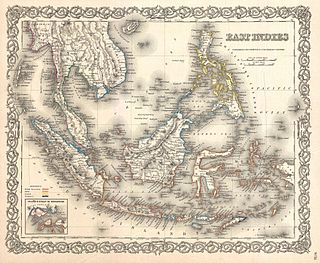
Cathay is a historical name for China that was used in Europe. During the early modern period, the term Cathay initially evolved as a term referring to what is now Northern China, completely separate and distinct from China, which was a reference to southern China. As knowledge of East Asia increased, Cathay came to be seen as the same polity as China as a whole. The term Cathay became a poetic name for China.

The Malay Archipelago also called Insulindia or the Indo-Australian Archipelago is the archipelago between Mainland Southeast Asia and Australia. It has also been called the "Malay world," "Nusantara", "East Indies", and other names over time. The name was taken from the 19th-century European concept of a Malay race, later based on the distribution of Austronesian languages.

An Historical Relation of the Island Ceylon together With somewhat Concerning Severall Remarkable passages of my life that hath hapned since my Deliverance out of Captivity is a book written by the English trader and sailor Robert Knox in 1681. It describes his experiences some years earlier in the Kingdom of Kandy, on the island today known as Sri Lanka. It provides one of the most important contemporary accounts of 17th century Sri Lankan life.

Pulicat or Pazhaverkadu is a historic seashore town in Chennai Metropolitan Area at Thiruvallur District, of Tamil Nadu state, India. It is about 60 kilometres (37 mi) north of Chennai and 3 kilometres (1.9 mi) from Elavur, on the southern periphery of the Pulicat Lake. Pulicat lake is a shallow salt water lagoon which stretches about 60 kilometres (37 mi) along the coast. With lakeside and seashore development as well as several Special Economic Zones (SEZs) including a US$1 billion Medical SEZ, coming up in nearby Elavur, land prices in the area are rising.
Duarte Fernandes was a Portuguese diplomat, explorer, and was the first European to establish diplomatic relations with Thailand, when in 1511 he led a diplomatic mission to Ayutthaya Kingdom, after the Portuguese conquest of Malacca. His daughter, Maria Nunes, was also the maternal grandmother of philosopher Baruch Spinoza.

Trịnh Tạc ruled northern Dai Viet in 1657–1682.
Elias Hesse was a German man who travelled through Southeast Asia in the 17th century, and the author of an account on the topic, Ost-Indische Reise-Beschreibung.
Motella, Metello(u)polis, or Pulcherianopolis was a city in the Roman province of Phrygia Pacatiana, in Asia Minor, probably on the site of the modern Yeşiloba (Medele).

François Pallu, MEP (1626–1684) was a French bishop. He was a founding member of the Paris Foreign Missions Society and became a missionary in Asia.

Antonius Hambroek was a Dutch missionary to Formosa from 1648 to 1661, during the Dutch colonial era. Prior to working in Formosa, Hambroek was a minister in Schipluiden between 1632 and 1647.

Arnoldus Montanus was a Dutch teacher and author who published books on theology, history, and geography of both the Netherlands and faraway countries.

Sephardic Jews in India are Iberian Jews who settled in many coastal towns of India, in Goa and Damaon, Madras and, primarily and for the longest period, on the Malabar coast in Cochin. After the Portuguese discovery of the sea route to India in the 1498, a number of Sephardic Jews fled Antisemitism in Iberia which had culminated in the Edict of Expulsion in 1492 and Persecution of Jews and Muslims by Manuel I of Portugal. They settled in Portuguese Indian trading places so that they could continue practicing Judaism secretly while still remaining within the Portuguese Empire. After the Portuguese Inquisition was established, an additional number of falsely-converted Sephardic Jews made sea voyages to settle in India, because it would then be difficult for the Inquisition to investigate and punish them. They spoke the vernacular language of their kingdom and some of them also Arabic.
François Martin de Vitré was a French sailor and adventurer from the town of Vitré who traveled to East Asia as far as Sumatra from 1601 to 1603. He was the first Frenchman to write an account of travels to the Far East. He was, however, preceded to the Far East by several French traders, such as Jean Parmentier in 1529. De Vitré was the surgeon of his ship.

Henri de Feynes, Comte de Monfart, Monsart or Montfort, was a 17th-century French explorer and adventurer who was the first Frenchman to visit China. He may have been sent on a secret mission by King Henry IV. Henri de Feynes arrived in China in 1609, after three years travelling on land and on the seas. He finally reached the city of Canton.

Fort Geldria or Fort Geldaria, located in Pulicat, Tamil Nadu, was the seat of the Dutch Republic's first settlement in India, and the capital of Dutch Coromandel. It was built by the Dutch East India Company in 1613 and became the local governmental centre in 1616. It was named for Geldria, the native province of Wemmer van Berchem, the General Director of the company. Regularly protected by a garrison of 80 to 90 men, Fort Geldria was the only fortification in the Indian empire; all other positions of the Dutch Company were trading posts.

The Pancha Bhuta Sthalam refers to five temples dedicated to Shiva, each representing a manifestation of the five prime elements of nature: earth, water, fire, air, and ether. Pancha indicates "five," Bhuta means "elements," and Sthala means "place." The temples are located in South India, four in Tamil Nadu and one in Andhra Pradesh. The five elements are believed to be enshrined in the five lingams of the temples, with each lingam named on the element represented. All five temples are located around the 78°E and 79°E longitudes and between 10°N and 14°N latitudes.

Dutch Celebes refers to the period of colonial governance on the island of Sulawesi - as a commandment of the Dutch East India Company from 1699 until its demise in the early 1800s, and then as a part of the Netherlands Indies or Dutch East Indies until 1945. Dutch presence in the region started with the capture of Sulawesi from the Portuguese, and ended with the establishment of the State of East Indonesia. Celebes is now referred to as Sulawesi. Makassar, the capital, was also referred to as: Macassar, Makassar, Macaçar, Mancaçar, or Goa, Gowa.

Indonesia is the common and official name to refer to the Republic of Indonesia or Indonesian archipelago; however, other names, such as Nusantara and East Indies are also known. Some names are considered obsolete and confined to certain periods of history, while some might be more geographically specific or general.

Districts, also known as rural districts or counties, are one of several types of second-tier administrative subdivisions of Vietnam, the other types being urban districts, provincial cities, municipal cities, and district-level towns. The districts are subdivisions of the first-tier divisions, namely the provinces and municipalities. Districts are subdivided into third-tier units, namely townships and communes.
Donald Frederick Lach was an American historian based as a professor in the Department of History at the University of Chicago. He was an authority on Asian influence in the European civilization during the sixteenth through the eighteenth centuries.
















